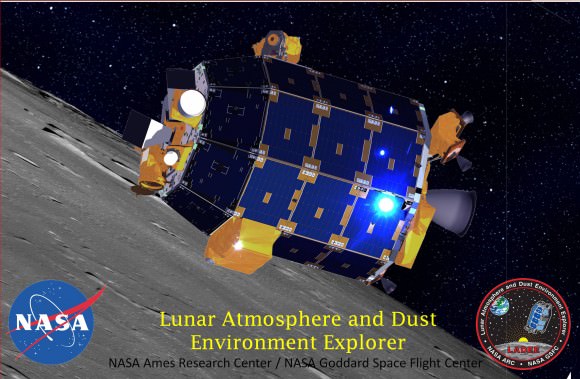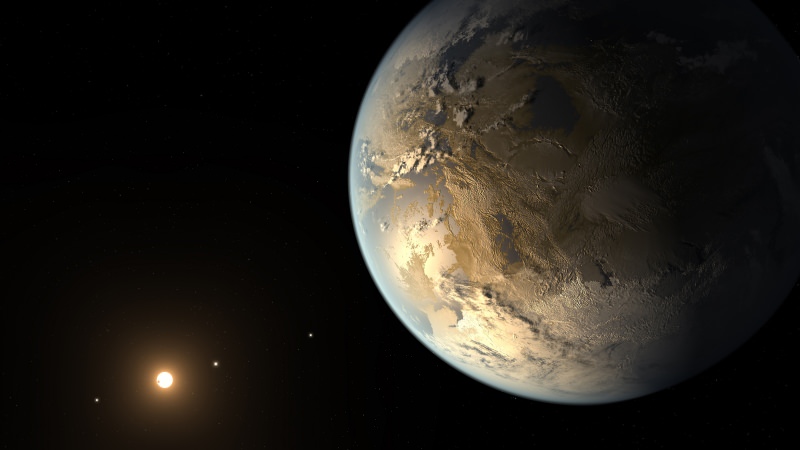Host: Fraser Cain
Guests: Casey Dreier, Brian Koberlein, Jason Major, Sondy Springmann, David Dickinson
Continue reading “Weekly Space Hangout – April 18, 2014: Another Earth, Dragon Launch, LADEE Impact”
NASA’s Highly Productive LADEE Dust Explorer Probe Crashes into the Moon as Planned
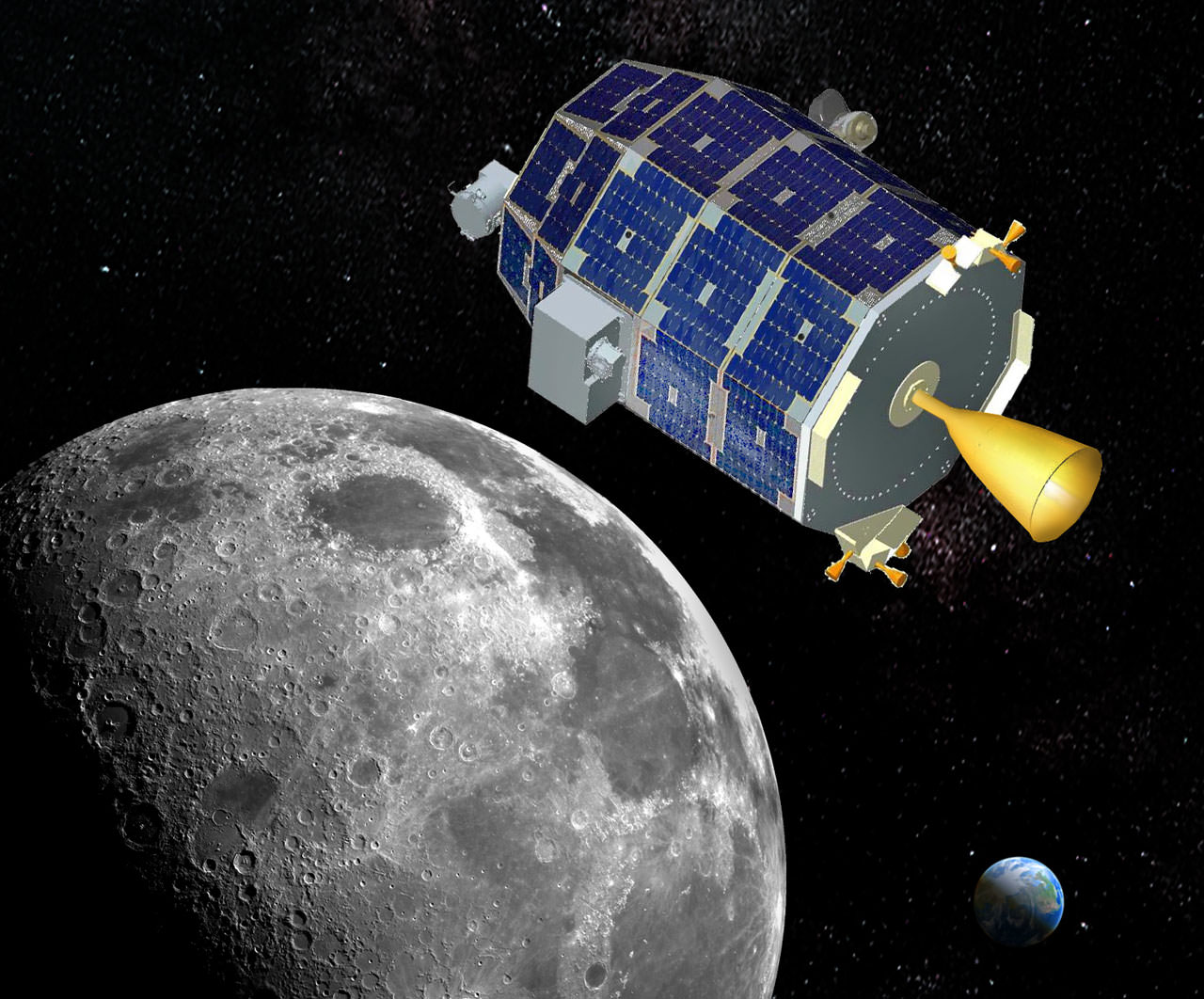
NASA’s LADEE lunar orbiting dust and atmosphere explorer probe has bitten the dust and crashed into the Moon’s surface exactly as planned following a fabulously successful and groundbreaking science mission that exceeded all expectations.
The Lunar Atmosphere and Dust Environment Explorer (LADEE) spacecraft impacted the far side of the Moon sometime overnight between 12:30-1:22 a.m. EDT, Friday, April 18 (9:30 and 10:22 p.m. PDT, Thursday, April 17) according to a NASA statement.
Running low on fuel and unable to continue any further science observations, the couch sized spacecraft was intentionally plunged into the rugged lunar surface at a spot designed to keep it far away from disturbing any of the historic Apollo manned lunar landing sites or unmanned surveyors on the Moon’s near side.
Mission controllers at NASA’s Ames Research Center allowed LADEE’s orbit to naturally decay following the conclusion of the probes extended mission in the final low orbit science phase.
The probe was likely smashed violently to smithereens and mostly vaporized from the heat generated upwards of several hundred degrees. Any surviving debris may be buried in shallow crater formed by the impact.
“At the time of impact, LADEE was traveling at a speed of 3,600 miles per hour – about three times the speed of a high-powered rifle bullet,” said Rick Elphic, LADEE project scientist at Ames, in a NASA statement.
“There’s nothing gentle about impact at these speeds – it’s just a question of whether LADEE made a localized craterlet on a hillside or scattered debris across a flat area. It will be interesting to see what kind of feature LADEE has created.”
The powerful NAC telescopic camera aboard NASA’s still orbiting Lunar Reconnaissance Orbiter (LRO) will be directed in coming months to try and photograph the impact site after engineers pinpoint the likely crash site.
LRO has already imaged LADEE while both were co-orbiting in different lunar orbits.
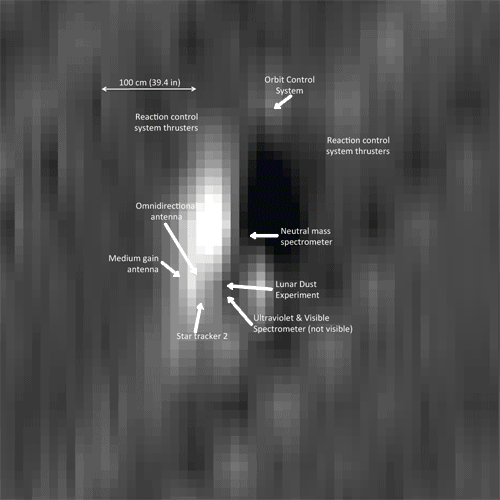
After completing its primary science mission in March, the already ultra low altitude of the lunar orbiting probe was reduced even further so that it was barely skimming just 2 kilometers (1 mile) above the pockmarked lunar surface.
Such a low altitude thus enabled LADEE to gather unprecedented science measurements of the Moon’s extremely tenuous atmosphere and dust particles since the species would be present at a higher concentration.
Lots of fuel is required to maintain LADEE’s orbit due to the uneven nature of the Moon’s global gravity field.
The final engine firing was commanded on April 11 to ensure a far side impact and the safety of all the historic lunar landing sites.
“LADEE also survived the total lunar eclipse on April 14 to 15. This demonstrated the spacecraft’s ability to endure low temperatures and a drain on batteries as it, and the moon, passed through Earth’s deep shadow,” said NASA
LADEE was launched on Sept. 6, 2013 from NASA Wallops in Virginia on a science mission to investigate the composition and properties of the Moon’s pristine and extremely tenuous atmosphere, or exosphere, and untangle the mysteries of its lofted lunar dust dating back to the Apollo Moon landing era.
All those objectives and more were accomplished during its nearly half year investigating Earth’s nearest neighbor.
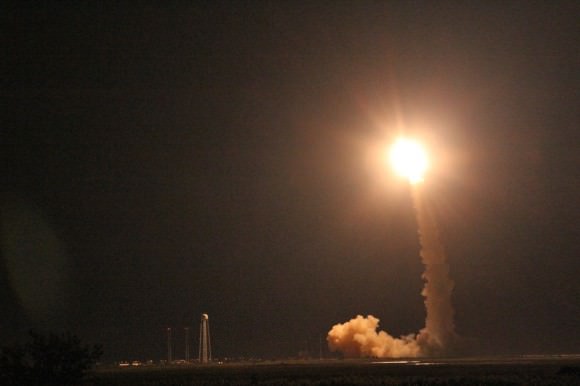
It entered lunar orbit on Oct. 6, 2013 amidst the ridiculous government shutdown that negatively affected a number of science missions funded across the US federal government.
The science mission duration had initially been planned to last approximately 100 days and finish with a final impact on the Moon on about March 24th.
NASA granted LADEE a month long extension since the residual rocket fuel was more than anticipated due to the expertise of LADEE’s navigation engineers and the precision of the launch atop the Orbital Sciences Minotaur V rocket and orbital insertion.
“It’s bittersweet knowing we have received the final transmission from the LADEE spacecraft after spending years building it in-house at Ames, and then being in constant contact as it circled the moon for the last several months,” said Butler Hine, LADEE project manager at Ames.
The 844 pound (383 kg) robot explorer was assembled at NASA’s Ames Research Center, Moffett Field, Calif., and is a cooperative project with NASA Goddard Spaceflight Center in Maryland.
The $280 million probe is built on a revolutionary ‘modular common spacecraft bus’, or body, that could dramatically cut the cost of exploring space and also be utilized on space probes to explore a wide variety of inviting targets in the solar system.
Stay tuned here for Ken’s continuing LADEE, Chang’e-3, Orion, Orbital Sciences, SpaceX, commercial space, Mars rover and more planetary and human spaceflight news.
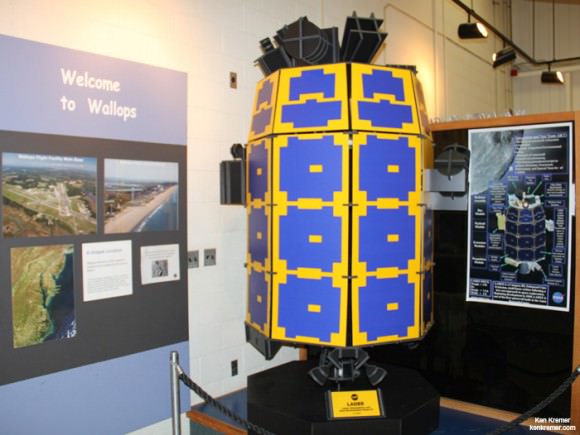
Urgent Spacewalk Must Dance Between Dragon and Progress Spacecraft
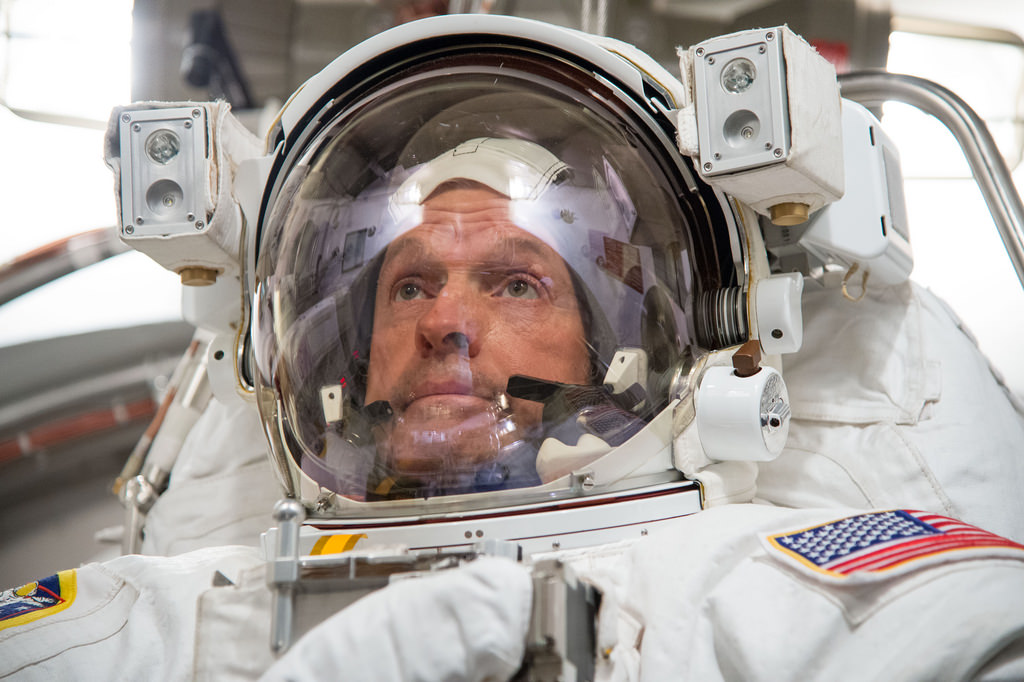
It’s a good thing that next week’s urgent spacewalk is pegged as a short one, because the coming days will be hectic for the Expedition 39 crew.
Finding a spot for even a 2.5-hour excursion on the International Space Station was extremely challenging, NASA officials said in a news conference today (April 18), because crew time also is needed for two cargo spacecraft: the SpaceX Dragon launch scheduled for today and subsequent Progress undocking/redocking on station.
Here’s a rundown of some things NASA was juggling as it moves hastily to replace a failed backup computer on the outside of the station. Rick Mastracchio and Steve Swanson are expected to go “outside” on Wednesday (April 23), but if today’s SpaceX launch is delayed the spacewalk will be moved up to Sunday (April 20).
Why it’s urgent
The U.S. portion of the station has 46 computers, with 24 of them external. The multiplexer/demultiplexer or MDM (one of two) controls 12 of these external computers and is responsible for everything for how the solar arrays are pointed to how some robotics operate. It should be noted here that the primary MDM is working just fine, but if it fails with no backup, there will be problems. NASA will lose telemetry or data from the external ammonia cooling systems operating on station (although the systems themselves will work automatically). Some redundant equipment can’t be turned on, either. The agency also won’t be able to point the solar arrays to get power or to move them aside when spacecraft come in, to protect the arrays from thruster plumes (although further below you can see some backups they have for the array problems.)
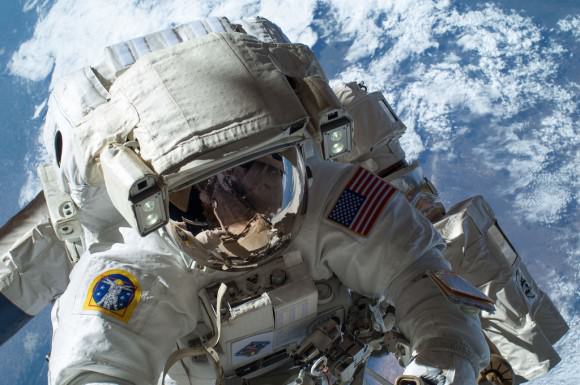
Fixing the spacesuits
Since last summer’s life-threatening water leak, NASA has been moving quickly to fix the spacesuits it has. All non-urgent spacewalks are off the table until at least this summer while NASA addresses a panel’s recommendations to fix the problem. A faulty fan pump separator was swapped out on the bad suit (Suit 3011) last December, but two spacesuits still needed to be fixed on station. The crew spent much of the past week changing out a fan pump separator on Suit 3005 (which will also be used in the spacewalk) and flushing out the cooling lines in the suit and on station, since contamination is believed to have led to the failure. (More parts will arrive on Dragon, but they won’t be used this time, NASA has determined.)
Spacewalk preps on the ground
Also today, NASA astronaut Chris Cassidy was in “the pool” (at NASA’s Neutral Buoyancy Laboratory) simulating the spacewalk. He’s part of a team working to see what could go wrong on the spacewalk and come up with procedures dealing with that. “As best we can we have all those answers in our hip pockets so as they get thrown out on the game day, we can give the crew a quick answer,” he said in an interview Wednesday (April 16) on NASA TV.
Preparing the new computer
A spare MDM is inside the station, but it was an older model that needed to be reconfigured. Astronauts changed out a processing card and did other hardware/software changes to prepare the MDM to sit outside of the station. They also thoroughly tested it to make sure it’s working before mounting it outside. As a point of interest, no one yet knows why the backup MDM failed, but astronauts will inspect the site for damage (and take pictures). It’s expected that once they bring the broken MDM inside, any failed cards will be swapped out and sent to the ground sometime for analysis. The MDM itself will stay on station to be used again, as needs arise.
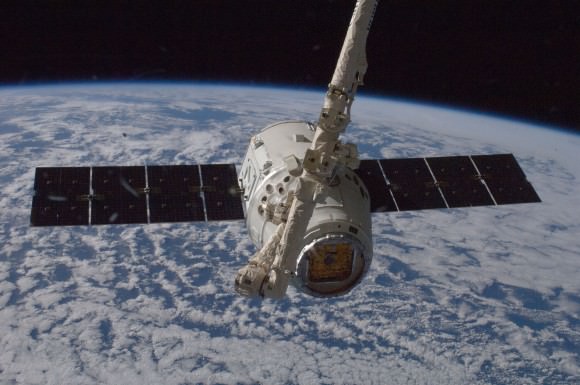
Grappling Dragon
SpaceX’s Dragon is a cargo spacecraft controlled by the ground, but the astronauts need to be ready to nab it with the robotic Canadarm2 once it arrives (now scheduled for Sunday, April 20). The crew has their normal amount of training and preparation for the procedures, then the time it takes to capture the spacecraft, and then the time to unload the vehicle (which is somewhat urgent as there are certain research experiments that need to come off fairly quickly, NASA said.)
Moving the solar array
NASA not only needs to have the solar arrays out of the way from thruster plumes from Dragon and Progress, but it also needs to keep power to the station and configure the arrays so that if the other MDM fails, the arrays will automatically be placed in a safe spot. The array would autotrack for 24 hours after the MDM fails, then go to a “preset angle” that NASA carefully chose. As for whether there would be power shortages on station, NASA says it depends on the sun’s angle and what needs to be done on station at a particular time.
Moving the Progress spacecraft
Russian cargo ship Progress 53 is supposed to undock from the Zvezda service module on Wednesday (April 23) to test an automated rendezvous system that controls approaches to station. Then it’s docking again on Friday (April 25).
Unless otherwise noted, information in this article is based on comments from the following officials in today’s NASA news conference: Mike Suffredini, International Space Station program manager; Brian Smith, International Space Station flight director and Glenda Brown, lead spacewalk officer.
Watch Live Webcast: Secrets of the Universe’s First Light
Just a month ago came the news of the first direct evidence of primordial gravitational waves — ripples in the fabric of spacetime — providing the first direct evidence the Universe underwent a brief but stupendously accelerated expansion immediately following the Big Bang.
This almost unimaginably fast expansion when the Universe was only a trillionth of a trillionth of a trillionth of a second was first theorized more than three decades ago, and the announcement last month was so monumental that some are comparing it to the discovery of the Higgs boson.
On April 18, 20:00 UTC (3 pm EDT, 1:00 pm PDT, two of the scientists who made this groundbreaking discovery will come together for a conversation with two of the pioneering leaders of the field. Together, they will examine the detection of a distinctive, swirling pattern in the universe’s first light, what the swirl tells us about that monumental growth spurt, and the many implications on the way we understand the universe around us.
You can watch below:
The hangout will include members of the BICEP2, which made the discovery, as well as two notable scientists in this field, John Carlstrom and Michael Turner.
Get Ready for the Lyrid Meteor Shower: Our Complete Guide for 2014
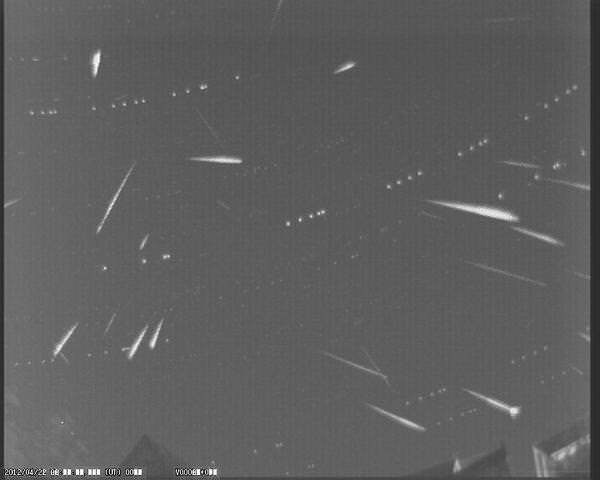
The month of April doesn’t only see showers that bring May flowers: it also brings the first dependable meteor shower of the season. We’re talking about the Lyrid meteors, and although 2014 finds the circumstances for this meteor shower as less than favorable, there’s still good reason to get out this weekend and early next week to watch for this reliable shower.
The Lyrid meteor shower typically produces a maximum rate of 10-20 meteors per hour, although outbursts topping over a hundred per hour have been observed on occasion. The radiant, or the direction that the meteors seem to originate from, lies at right ascension 18 hours and 8 minutes and declination +32.9 degrees north. This is just about eight degrees to the southwest of the bright star Vega, which is the brightest star in the constellation of Lyra the Lyre, which also gives the Lyrids its name.
Fun fact: this radiant actually lies juuusst across the border of Lyra in the constellation of Hercules… technically, the “Lyrids” should be the “Herculids!” This is because the shower was identified and named in the 19th century before the International Astronomical Union officially adopted the modern layout we use for the constellations in 1922.
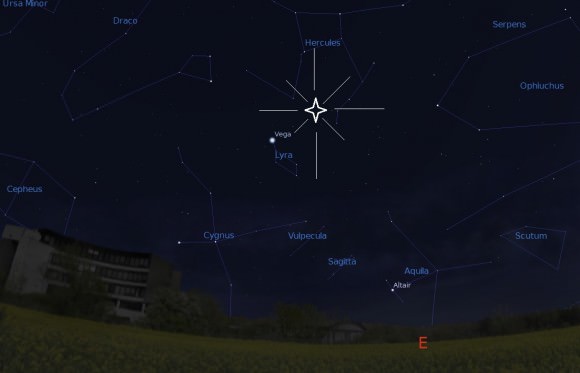
The source of the Lyrids was tracked down in the late 1860s by mathematician Johann Gottfried Galle to Comet C/1861 G1 Thatcher, the path of which came within 0.02 Astronomical Units (A.U.s) of the Earth’s orbit on April 20th, 1861, just six weeks before the comet reached perihelion. Comet G1 Thatcher is on a 415 year orbit and won’t return to the inner solar system until the late 23rd century.
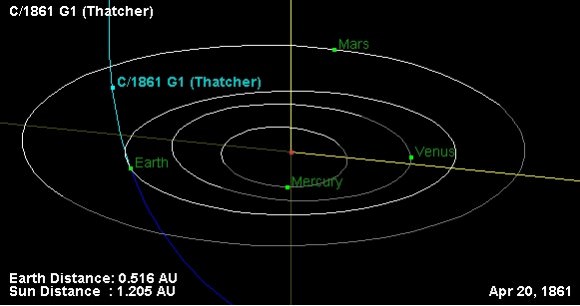
But we can enjoy the dust grains it left in its wake as they greet the Earth to burn up in its atmosphere every April. The activity of the Lyrids typically spans April 16th to the 25th, with a short 24 hour peak above a ZHR of 10 on April 22nd-23rd. Thus, like the short duration Quadrantids in January, timing is critical; if you happen to observe this shower before or after the peak, you may see nothing at all. This year, the key mornings will be Tuesday, April 22nd, and Wednesday April 23rd. The wide disparity of predictions for the exact arrival of the peak of the Lyrids, as quoted in differing sources speaks to just how poorly this meteor shower is understood. Scanning various reliable resources, we see times quoted from April 22nd at 4:00 Universal Time (UT) from the American Meteor Society, to 17:00 UT on the same date for the Royal Canadian Astronomical Society, to April 23rd at 17:45 UT from Guy Ottewell’s venerable 2014 Astronomical Calendar!
Definitely, more observations of this curious shower are needed.
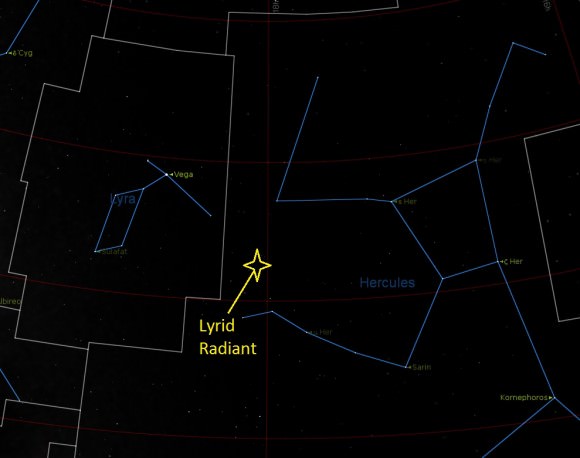
Now for the bad news. This year finds the light-polluting Moon in nearly its worst location possible for a meteor shower. Remember this week’s total lunar eclipse? Well, the Moon is now waning gibbous and will reach last quarter phase at 7:52 UT/3:52 AM EDT on April 22nd, and will thus be rising at local midnight and be high in the sky towards dawn. The Lyrid radiant rises at 9:00 PM this week for observers around 40 degrees north and rides highest at 6:00 AM local, about 45 minutes before sunrise.
Looking at the International Meteor Organization’s historical data, here’s what the Lyrids have done over the past few years:
2013- ZHR 22, Moon phase= 88% illuminated, waxing gibbous.
2012– ZHR 25, Moon phase= 2% illuminated, waxing crescent.
2011- ZHR 20, Moon phase= 73% illuminated waning gibbous.
2010- ZHR 32, Moon phase= 62% illuminated waxing gibbous.
2009- ZHR 15, Moon phase= 7% illuminated waning crescent.
A “ZHR” is the Zenithal Hourly Rate, a theoretical maximum number of meteors that an observer could expect to witness under dark skies if the radiant was straight overhead. Note that 2011 had similar circumstances with respect to the Moon as this year, so don’t despair! The Lyrids are approaching the Earth from nearly perpendicular in its orbit and have a head on velocity of about 48 kilometres per second, respectable for a meteor shower. They also present a higher-than-average number of fireballs, with about a quarter leaving persistent trains.
Outbursts have also occurred in 1803, 1849, 1850, 1922, 1945 and 1982. United States observers based in Florida and Colorado noted a brief ZHR approaching 100 per hour back in 1982 under especially favorable New Moon conditions.
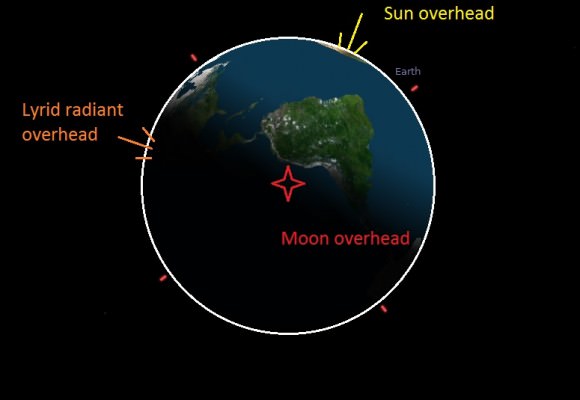
Ironically, the Lyrids are also one of the oldest meteor showers identified from historic records. In fact, Galle actually traced the shower back to Chinese records dating all the way back to March 16th 687 BC, which describes “Stars (that) dropped down like rain…” clearly, the Lyrids were considerably more active in ancient times.
More recently, attempts were made to link the 2012 Sutter’s Mill meteorite fall to the Lyrids, which were underway at the time. This turned out to be a case of “meteor-wrong,” however, as described by Geoff Notkin of the Meteorite Men who noted that no meteorite fall has ever been linked to a meteor shower, though he does get lots of calls whenever news of a big meteor shower hits the press.
A good strategy for beating the Moon includes blocking it behind a hill or building while observing. Early morning is the best time to watch for Lyrids — or most any meteor shower for that matter — as you’re then on the half of the Earth facing forward into the meteor stream. And you don’t have to face toward the radiant to see Lyrid meteors, as they can appear anywhere in the sky.
With the advent of DSLRs, photographing meteors is easier than ever before. All you need to do is use a wide angle lens and take periodic time exposures of the sky. Do a few early test shots to get the combination of f-stop, ISO and shutter speed just right for current sky conditions, and be sure to review those images on a full size monitor afterward: nearly every meteor we’ve captured turned up in post-review only.
Looking to contribute to our understanding of the Lyrid meteors? Simply count the number you see and the location and length of your observation and send your report into the International Meteor Organization. And don’t forget to tweet those Lyrids to #Meteorwatch!
…and there’s more to come. Next month, a true “wildcard outburst” may be in the offing from Comet 209P/LINEAR on May 26th… can you say “Camelopardalids?”
Stay tuned!
SpaceX Dragon launch to ISS Marches Towards April 18 Liftoff after Helium Leak Forces Scrub – Watch Live
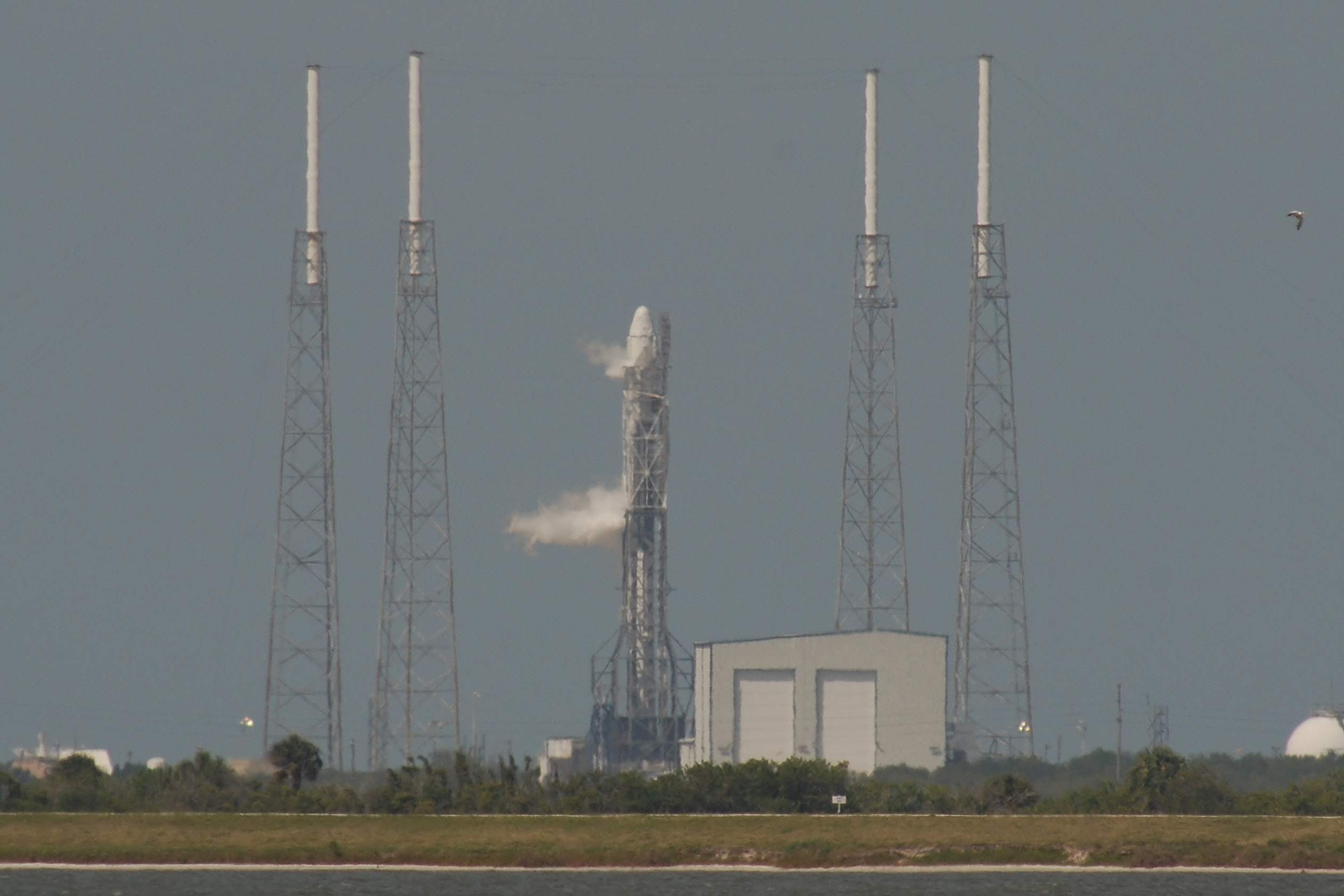
NASA and SpaceX are marching forward towards a Friday, April 18 liftoff attempt for the Falcon 9 rocket sending a commercial Dragon cargo craft on the company’s third resupply mission to the International Space Station following the scrubbed launch attempt on Monday, April 14 – forced by the discovery of a Helium gas leak inside the rocket during the latter stages of the countdown.
An on time blastoff of the upgraded Falcon 9 sets the stage for an Easter Sunday rendezvous and berthing of the Dragon resupply spacecraft at the massive orbiting outpost packed with almost 5000 pounds of science experiments and supplies for the six person crew.
However the weather prognosis is rather iffy for Friday afternoons launch attempt at 3:25:21 p.m. EDT from Space Launch Complex 40 at Cape Canaveral Air Force Station in Florida.
Forecasters predict only a 40 percent “GO” of acceptable weather conditions at the appointed liftoff time of the SpaceX-3 mission – roughly the time when the Earth’s rotation moves the rocket into the plane of the space stations orbit.
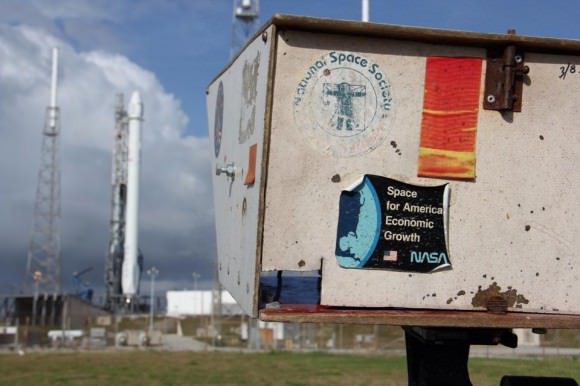
Meteorologists with the U.S. Air Force 45th Weather Squadron are predicting a significant chance of rain showers and thunderstorms in the Florida Space coast launch area that could violate three launch rules, namely the Thick Cloud, Lightning and Flight Through Precipitation rules.
In the event of a scrub for any reason on Friday, NASA, SpaceX and Air Force managers approved another backup launch opportunity on Saturday, April 19 at 3:02:42 p.m.
The weather outlook for a Saturday liftoff improves somewhat to 60 percent “GO”.
Originally, Monday and Friday were the only available launch target dates this week.
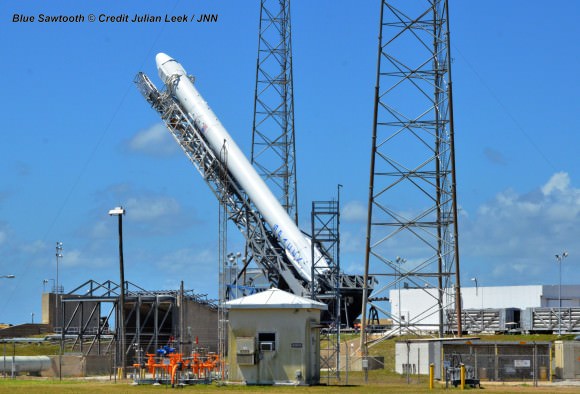
Assuming a successful Falcon 9 launch on Friday, station crew members Rick Mastracchio and Steven Swanson will grapple the Dragon cargo freighter with the 57 foot long Canadarm2 on Easter Sunday morning, April 20, at 7:14 a.m. at then berth it at the Earth-facing port of the Harmony module.
You can watch the launch live on NASA TV: http://www.nasa.gov/ntv
NASA TV live coverage will begin at at 2:15 p.m. EDT
SpaceX live launch coverage begins at 2:45 p.m. ET: Webcast at www.spacex.com/webcast
NASA TV coverage of the Easter Sunday grappling process will begin at 5:45 a.m. with berthing coverage beginning at 9:30 a.m. : http://www.nasa.gov/ntv
Monday’s launch attempt was scrubbed about an hour before liftoff when SpaceX mission controllers and engineers detected that a helium valve in the pneumatic system for stage separation between the first and second stages was not holding the specified pressure.
The success of the mission was therefore dependent on the perfect operation of a backup check valve for the stage separation pistons.
Although no technical issues were detected with the backup valve, the anamolous situation violated SpaceX launch rules.
“SpaceX policy is not to launch with any known anomalies,” said SpaceX in a statement.

The erect Falcon 9 was lowered back to the horizontal position so that SpaceX engineers could swap out the faulty helium valve, as well as conduct a complete inspection of the rocket to look for signs of any other issues that may have contributed to the valve not working as designed, said SpaceX.
This unmanned SpaceX mission dubbed CRS-3 will deliver some 5000 pounds of science experiments, a pair of hi tech legs for Robonaut 2, a high definition imaging camera suite, an optical communications experiment (OPALS) and essential gear, the VEGGIE lettuce growing experiment, spare parts, crew provisions, food, clothing and supplies to the six person crews living and working aboard the ISS soaring in low Earth orbit under NASA’s Commercial Resupply Services (CRS) contract.
To date SpaceX has completed two operational cargo resupply missions and a test flight. The last flight dubbed CRS-2 blasted off a year ago on March 1, 2013 atop the initial version of the Falcon 9 rocket.
NASA awarded contracts to SpaceX and competitor Orbital Sciences to develop unmanned cargo freighters via CRS to restore US capability to resupply the ISS following the shutdown of the space shuttle program in 2011.
SpaceX is under contract to NASA to deliver 20,000 kg (44,000 pounds) of cargo to the ISS during a dozen Dragon cargo spacecraft flights through 2016 at a cost of about $1.6 Billion.
The next launch of Orbital Sciences Antares/Cygnus commercial rocket to the ISS from NASA Wallops, VA, is tentatively slated for May 6. But the target date hinges on when this SpaceX-3 mission actually flies and could slip into mid-June.
Stay tuned here for Ken’s continuing SpaceX, Orbital Sciences, commercial space, Orion, Chang’e-3, LADEE, Mars rover, MAVEN, MOM and more planetary and human spaceflight news.
Kepler Has Found the First Earth-Sized Exoplanet in a Habitable Zone!
It’s truly a “eureka” moment for Kepler scientists: the first rocky Earth-sized world has been found in a star’s habitable “Goldilocks” zone, the narrow belt where liquid water could readily exist on a planet’s surface without freezing solid or boiling away. And while it’s much too soon to tell if this really is a “twin Earth,” we can now be fairly confident that they do in fact exist.
The newly-confirmed extrasolar planet has been dubbed Kepler-186f. It is the fifth and outermost planet discovered orbiting the red dwarf star Kepler-186, located 490 light-years away. Kepler-186f completes one orbit around its star every 130 days, just within the outer edge of the system’s habitable zone.
The findings were made public today, April 17, during a teleconference hosted by NASA.
“This is the first definitive Earth-sized planet found in the habitable zone around another star,” says lead author Elisa Quintana of the SETI Institute at NASA Ames Research Center. “Finding such planets is a primary goal of the Kepler space telescope. The star is a main-sequence M-dwarf, a very common type. More than 70 percent of the hundreds of billions of stars in our galaxy are M-dwarfs.”

Unlike our Sun, which is a G-type yellow dwarf, M-dwarf stars (aka red dwarfs) are much smaller and dimmer. As a result their habitable zones are much more confined. But, being cooler stars, M-dwarfs have long lifespans, offering planets in their habitable zones — like Kepler-186f — potentially plenty of time to develop favorable conditions for life.
In addition, M-dwarfs are the most abundant stars in our galaxy; 7 out of 10 stars in the Milky Way are M-dwarfs, although most can’t be seen by the naked eye. Finding an Earth-sized planet orbiting one relatively nearby has enormous implications in the hunt for extraterrestrial life.
“M dwarfs are the most numerous stars,” said Quintana. “The first signs of other life in the galaxy may well come from planets orbiting an M dwarf.”
Read more: Earthlike Exoplanets Are All Around Us
Still, there are many more conditions on a planet that must be met for it to be actually habitable. But size, composition, and orbital radius are very important first steps.
“Some people call these habitable planets, which of course we have no idea if they are,” said Stephen Kane, an assistant professor of physics and astronomy at San Francisco State University in California. “We simply know that they are in the habitable zone, and that is the best place to start looking for habitable planets.”
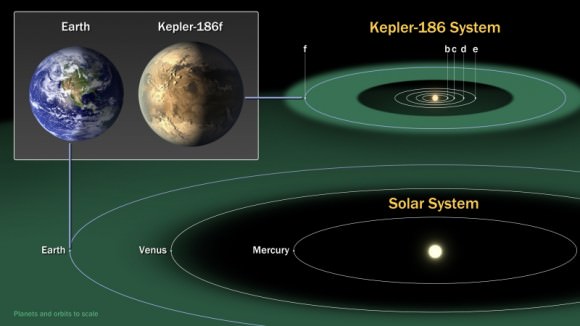
As far as the planetary system’s age is concerned — which relates to how long life could have potentially had to evolve on Kepler-186f’s surface — that’s hard to determine… especially with M-dwarf stars. Because they are so stable and long-lived, once they’re formed M-dwarfs essentially stay the same throughout their lifetimes.
“We know it’s probably older than a few billion years, but after that it’s very difficult to tell,” BAERI/Ames scientist Tom Barclay told Universe Today. “That’s the problem with M-dwarfs.”
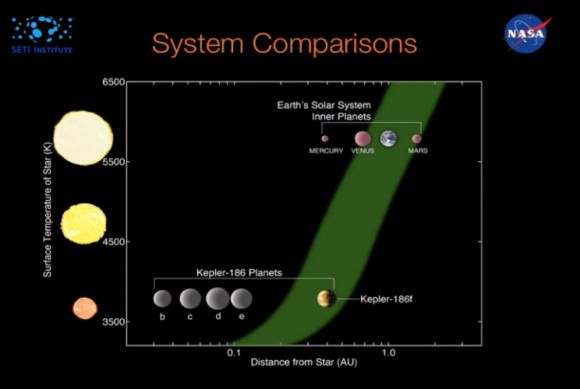
The exoplanet was discovered via the transit method used by NASA’s Kepler spacecraft, whereby stars’ brightnesses are continually monitored within a certain field of view. Any dips in luminance reveal the likely presence of a passing planet.
Because of its small size — just slightly over 1 Earth radius — and close proximity to its star, Kepler-186f can’t be observed directly with current telescope technology.
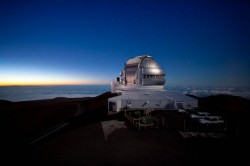
“However, what we can do is eliminate essentially all other possibilities so that the validity of these planets is really the only viable option,” said Steve Howell, Kepler project scientist and a co-author on the paper.
Using the latest advanced imaging capabilities of the Gemini North and Keck II observatories located atop Mauna Kea in Hawaii, astronomers were able to determine that the signals detected by Kepler were from a small orbiting planet and not something else, such as a background or companion star.
“The Keck and Gemini data are two key pieces of this puzzle,” Quintana said. “Without these complementary observations we wouldn’t have been able to confirm this Earth-sized planet.”
Kepler-186f joins the other 20 extrasolar worlds currently listed in the Habitable Exoplanets Catalog, maintained by the Planetary Habitability Laboratory at the University of Puerto Rico at Arecibo. To date 961 exoplanets have been confirmed through Kepler observations, with 1,696 total confirmed altogether. (Source)
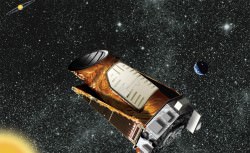
Read more: Mega Discovery! 715 Alien Planets Confirmed Using a New Trick on Old Kepler Data
Whether Kepler-186f actually resembles Earth or not, this discovery provides more information on the incredible variety of planetary systems to be found even in our little corner of the galaxy.
“The diversity of these exoplanets is one of the most exciting things about the field,” Kane said. “We’re trying to understand how common our solar system is, and the more diversity we see, the more it helps us to understand what the answer to that question really is.”
The SETI Institute’s Allen Telescope Array has surveyed the Kepler-186 system for any potential signals but so far none has been detected. Further observations are planned.
“Kepler-186f is special because we already know that a planet of its size and distance is capable of supporting life.”
– Elisa Quintana, research scientist, SETI Institute
The team’s paper, “An Earth-sized Planet in the Habitable Zone of a Cool Star” by Elisa V. Quintana et al., will be published in the April 18 issue of Science.
Learn more about the Kepler mission here, and read more about this discovery in NASA’s news release here and on the W.M. Keck website here.
Watch some video excerpts of team interviews and data renderings below:
Also, you can download the slides used in the NASA teleconference here.
Sources: San Francisco State University, Gemini Observatory, W.M. Keck Observatory, and SETI news releases
Ceres and Vesta Converge in Virgo, Watch it Happen With Just Binoculars
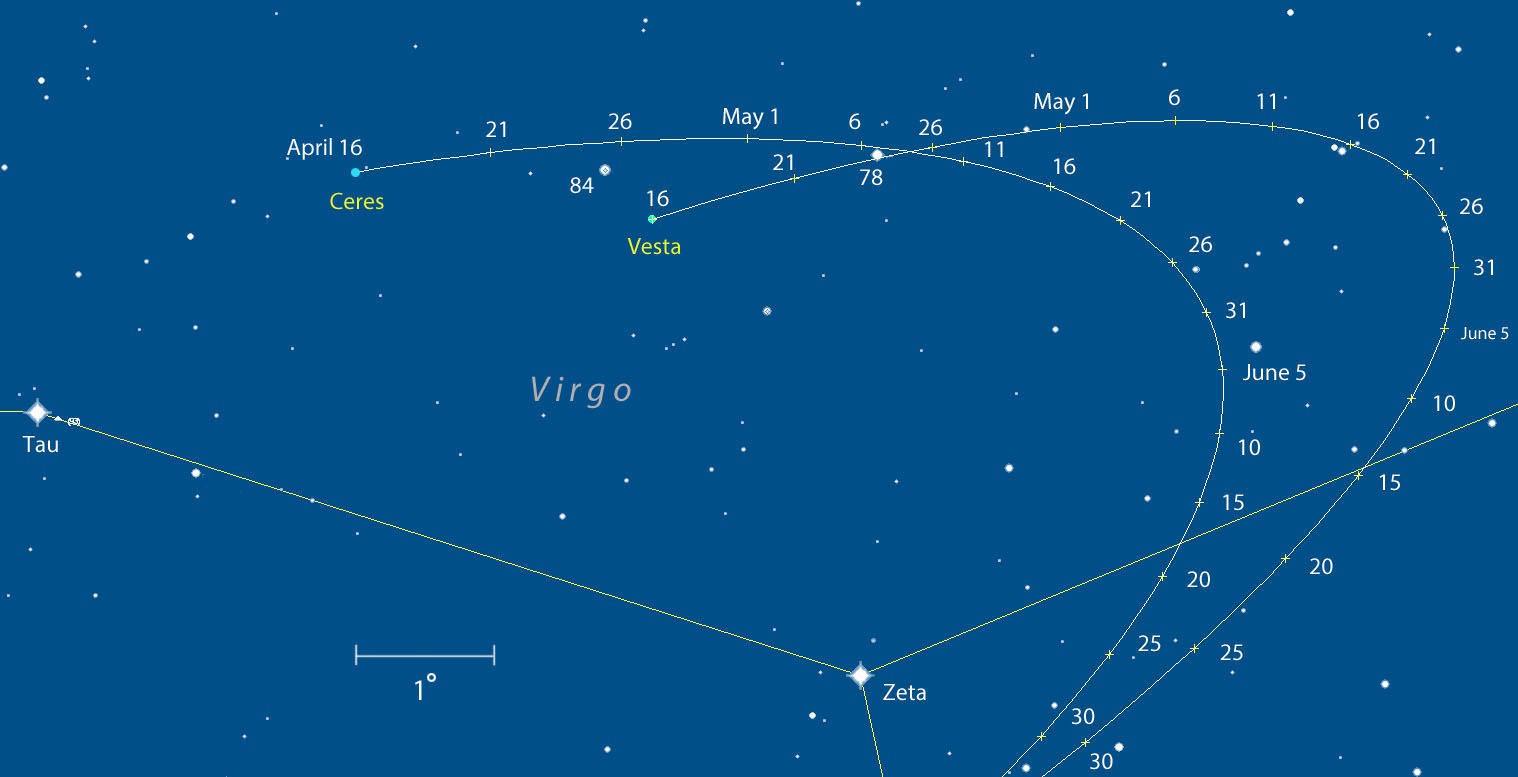
Don’t let them pass you by. Right now and continuing through July, the biggest and brightest asteroids will be running on nearly parallel tracks in the constellation Virgo and so close together they’ll easily fit in the same binocular field of view. The twofer features Ceres (biggest) and Vesta (brightest) which are also the prime targets of NASA’s Dawn Mission. Now en route to a Ceres rendezvous next February, Dawn orbited Vesta from July 2011 to September 2012 and sent back spectacular photos of two vast impact basins, craters stained black by carbon-rich asteroids and parallel troughs that stretch around the 330-mile-wide world like rubber bands.
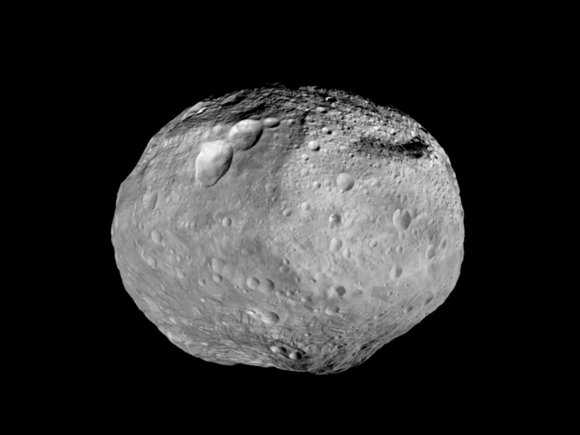
Astronomers used Dawn’s gravity data to discover Vesta is more like a planet than anyone had supposed. Deep beneath its crust, composed of lighter minerals, lies a denser iron core. Most asteroids were too small to generate enough interior heat through the decay of radioactive elements to melt and “differentiate” into core, mantle and crust like the terrestrial planets. Thanks to our new understanding, you’ll hear Vesta referred to as a ‘baby planet’.
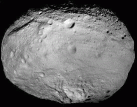
Studies of its crustal rocks showed a match to a clan of basaltic meteorites called howardites, eucrites and diogenites. Many of these formerly volcanic rocks that trace their origin to Vesta are found in numerous private and institutional collections. With a little homework, you can even buy a slice of Vesta on eBay, making for one of the least expensive sample return missions ever undertaken.
Dawn’s Greatest Hits at Vesta – A quick summary of key discoveries accompanied by electric guitar
While Vesta is a rocky body, Ceres shows telltale signs of water and iron-rich clay. Like Vesta, it also appears to have cooked itself into denser core and lighter crust. Because Ceres is less dense than Earth, astronomers believe water ice may be buried beneath its dusty crust.
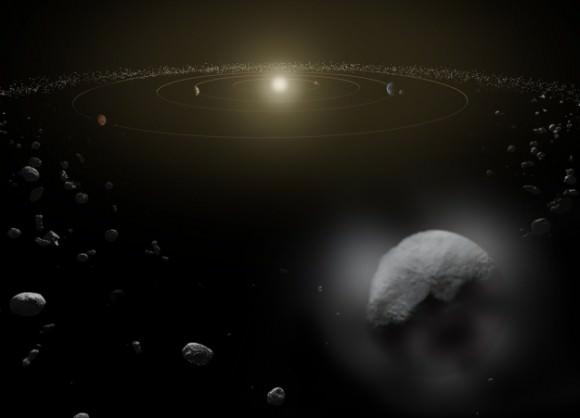
Earlier this year, astronomers working with the Herschel Space Telescope announced the discovery of plumes of water vapor blasting from two regions on the dwarf planet’s surface. While Ceres is an asteroid it’s also a member of a select group of dwarf planets, bodies large enough to have crunched themselves into spheres through their own gravity but not big enough to clear the region they orbit of smaller asteroids.
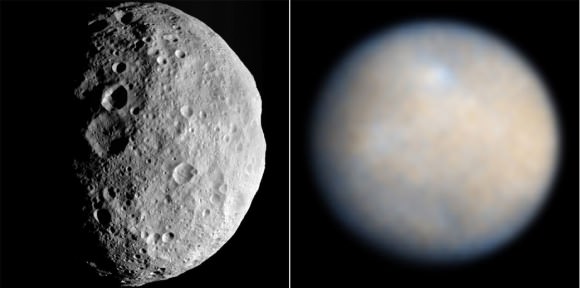
Ceres and Vesta will be gradually drawing closer in the coming weeks and months until on July 5 only 10 arc minutes (one-third the diameter of a full moon) will separate them. They’ll also be fading, but not so much that binoculars won’t show them throughout this excellent dual apparition. Vesta will only dim to magnitude +7 by July 1, Ceres to 8.4. Come mid-June I’ll return with a detailed map showing how best to see the dynamic duo during their close conjunction.
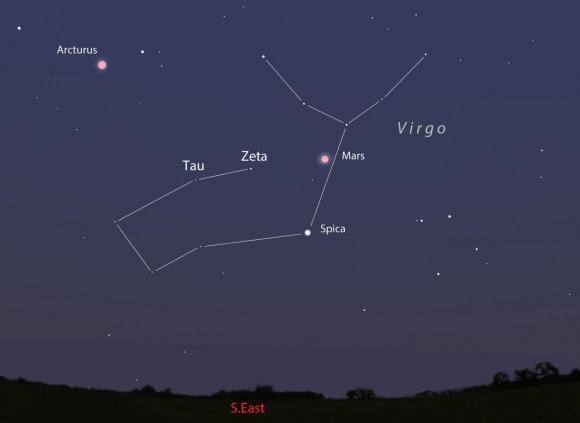
Sure, both Ceres and Vesta look exactly like stars even in large amateur telescopes, but sampling photons from real asteroids while listening to the sound of frogs on a spring night is my idea of a good time. Maybe yours too. Good luck!
New Hubble View Shows Objects a Billion Times Fainter Than Your Eyes Can See

While this image isn’t as deep as the Hubble Deep Field, this 14-hour exposure by the Hubble Space Telescope shows objects around a billion times fainter than what can be seen with the human eyes alone. Astronomers say this image also offers a remarkable depth of field that lets us see more than halfway to the edge of the observable Universe.
As well, this image also provides an extraordinary cross-section of the Universe in both distance and age, showing objects at different distances and stages in cosmic history, and ranges from some of our nearest neighbors to objects seen in the early years of the Universe.
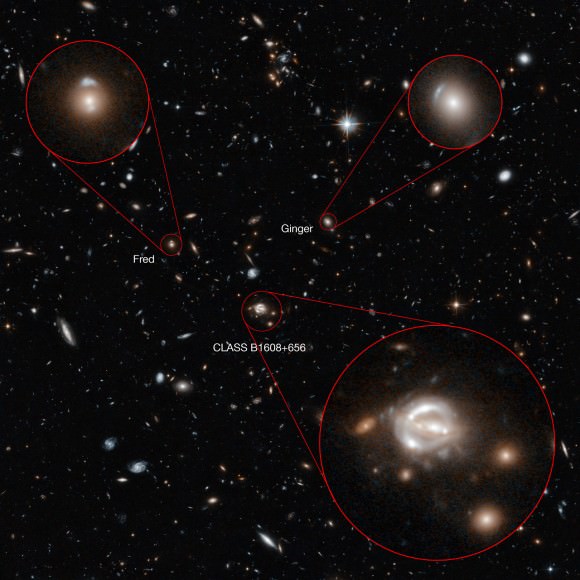
Most of the galaxies visible here are members of a huge cluster called CLASS B1608+656, which lies about five billion light-years away. But the field also contains other objects, both significantly closer and far more distant, including quasar QSO-160913+653228 which is so distant its light has taken nine billion years to reach us, two thirds of the time that has elapsed since the Big Bang.
Since the Hubble Deep Field combined 10 days of exposure and the eXtreme Deep Field, or XDF was assembled by combining ten years of observations (with over 2 million seconds of exposure time), this image at 14 hours of exposure may seem “small.” But it shows the power of the Hubble Space Telescope.
Also of note is that this image was “found” in the Hubble Hidden Treasures vault — where members of the public are able to search Hubble’s science for the best overlooked images that have never been seen by a general audience. This image of CLASS B1608+656 has been well-studied by scientists over the years, but this is the first time it has been published in full online.
Take a zooming view through the image in the video below and read more about this image here.
Source: Hubble ESA
SpaceX Leases Historic Launch Complex 39A from NASA for new Era of Commercial Space Launches
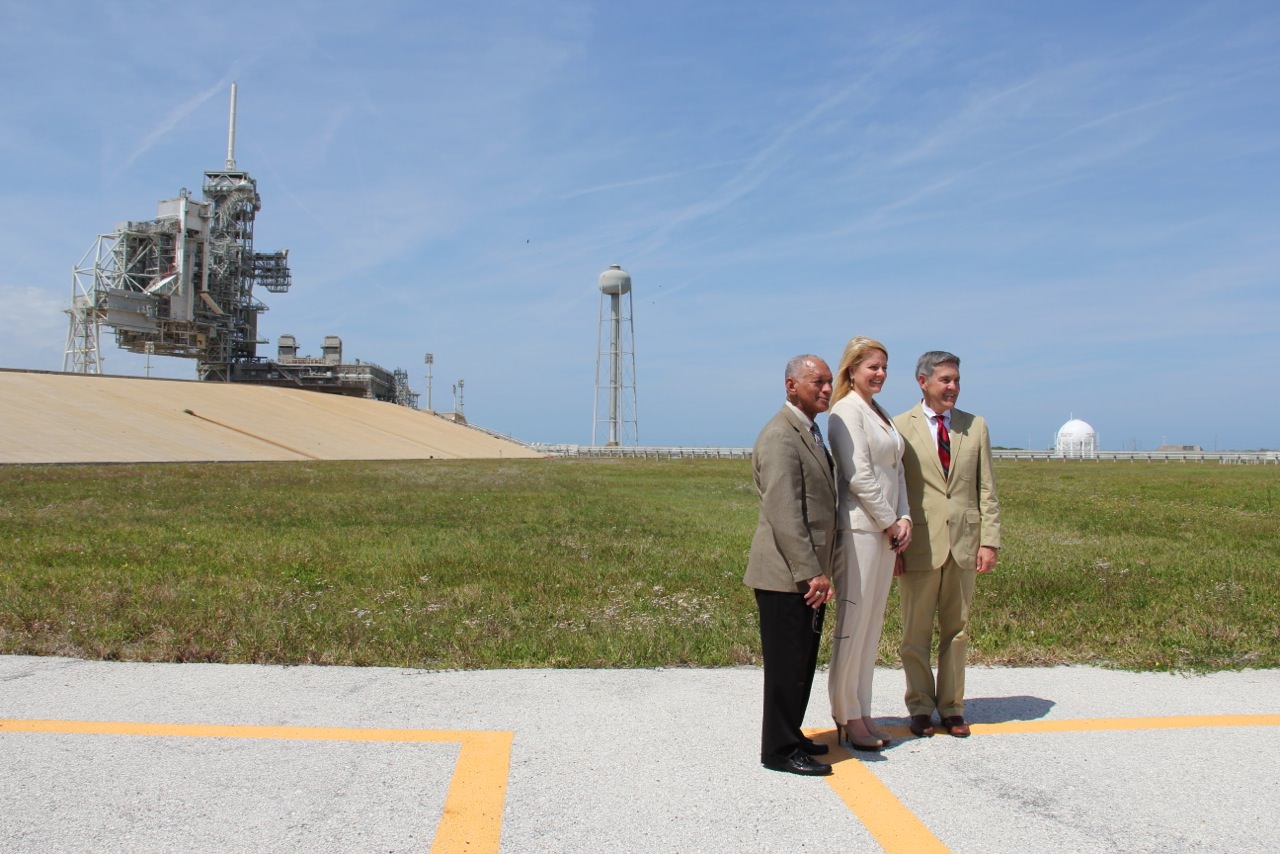
The keys to NASA’s historic launch Pad 39A that propelled humanity’s first man to walk on the Moon – Neil Armstrong – during the history making flight of Apollo 11, have been handed over to new owners, namely the private aerospace firm SpaceX for a new purpose – serving as a commercial launch facility.
NASA and Space Exploration Technologies Corporation (SpaceX) of Hawthorne, Calif., have just signed an agreement giving SpaceX rights to occupy and operate seaside Launch Complex 39A at the Kennedy Space Center (KSC) in Florida.
SpaceX was founded by billionaire, entrepreneur and space visionary Elon Musk.
SpaceX aims to give the now dormant pad a new lease on life in the emerging New Space era by revitalizing it as a commercial launch site for the company’s mammoth new Falcon Heavy rocket, currently under development, as well as for manned launches of the firm’s human rated Dragon spacecraft atop the Falcon 9 according to Gwynne Shotwell, president of SpaceX.
“We’ll make great use of this pad, I promise,” Shotwell told reporters at a briefing at the pad.
The liquid fueled Falcon Heavy will be the most powerful rocket in the world according to SpaceX, generating generating nearly four million pounds of liftoff thrust from 27 engines and thus significantly exceeding the power of the Delta IV Heavy manufactured by competitor United Launch Alliance.
Shotwell said renovations to pad 39A would start later this year. The maiden SpaceX launch from the complex is expected next year.
“We will launch the Falcon Heavy from here from this pad early next year,” Shotwell stated.

The SpaceX Dragon is one of three commercial crew vehicles being developed under a public-private partnership with NASA to ferry US astronauts to the International Space Station (ISS) and restore America’s human spaceflight capability lost since the shuttle’s retirement.
The Boeing CST-100 and Sierra Nevada Dream Chaser are also vying for the next round of private ‘space taxi’ funding from NASA.
Pad 39A has been inactive and mothballed since the last shuttle mission, STS-135, thundered to space in July 2011.
Not a single rocket has rolled up the ramp at KSC in nearly 3 years.

Credit: Ken Kremer/kenkremer.com
The new lease agreement was signed by NASA and SpaceX officials and announced onsite at Pad 39 at the briefing.
“Today this historic site from which numerous Apollo and space shuttle missions began and from which I first flew and left the planet on STS-61C on Columbia, is beginning a new mission as a commercial launch site,” said NASA Administrator Charles Bolden.
“While SpaceX will use pad 39A at Kennedy, about a mile away on pad 39B, we’re preparing for our deep space missions to an asteroid and eventually Mars. The parallel pads at Kennedy perfectly exemplify NASA’s parallel path for human spaceflight exploration — U.S. commercial companies providing access to low-Earth orbit and NASA deep space exploration missions at the same time.”
Under terms of the new agreement with NASA, the lease with SpaceX spans 20 years.
“It’s exciting that this storied NASA launch pad is opening a new chapter for space exploration and the commercial aerospace industry,” said Bolden.
SpaceX will also maintain and operate Pad 39A at its own expense, with no US federal funding from NASA.
Pad 39A will be SpaceX’s third launch site. The company also launches its Falcon 9 rockets from nearby Pad 40 on Cape Canaveral Air Force Station and a west coast pad on Vandenberg Air Force Base, Calif.
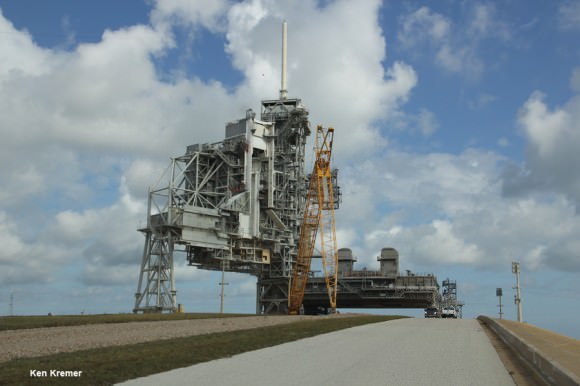
The next Falcon 9 liftoff with an unmanned Dragon cargo freighter is currently slated from Friday, April 18 following Monday’s scrub.
NASA determined that the agency no longer has a use for pad 39A since the end of the shuttle era and has been looking for a new tenant to take over responsibility and pay for maintenance of the launch complex. The agency awarded the lease to SpaceX in December 2013.
Instead, NASA decided to completely upgrade, renovate and modernize Pad 39As twin, namely Launch Pad 39B, and invested in converting it into a 21st Century launch complex.
NASA will use Pad 39B to launch the state of the art Orion crew vehicle atop the new Space Launch System (SLS) booster for voyages beyond Earth and taking humans back to the vicinity of the Moon and further out on deep space missions to Asteroids, Mars and beyond.
The first unmanned SLS test flight from Pad 39B is slated for late 2017.
Pad 39A was an active NASA launch pad for nearly 35 years starting back near the dawn of the Space Age in the 1960s.
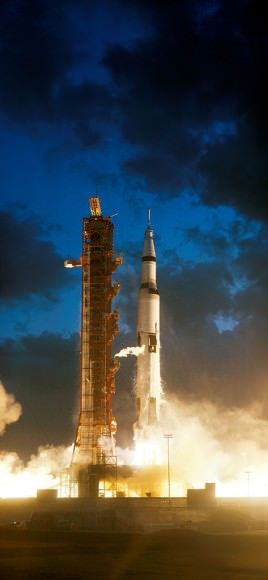
Apollo 4 was the first NASA booster to blast off from Pad 39A on Nov. 9, 1967 during the historic inaugural test flight of the Saturn V moon rocket that eventually served to dispatch all six US manned lunar landing missions.
The closing NASA use of Pad 39A took place on July 8, 2011 with the launch of STS-135 and orbiter Atlantis on the final flight of the space shuttle era.
The four person STS-135 crew delivered the last US pressurized module to the massive low-Earth orbiting ISS.
No Americans have launched to space from American soil since STS-135.
Launch Complex 39 was originally constructed to launch the Apollo moon landing missions atop NASA’s Saturn V booster in the 1960s and 1970s. Both pads were later modified to support the Space Shuttle program whose first launch took place in 1981 from pad 39A.
“Kennedy Space Center is excited to welcome SpaceX to our growing list of partners,” Center Director Bob Cabana said. “As we continue to reconfigure and repurpose these tremendous facilities, it is gratifying to see our plan for a multi-user spaceport shared by government and commercial partners coming to fruition.”
Stay tuned here for Ken’s continuing SpaceX, Orbital Sciences, commercial space, Orion, Chang’e-3, LADEE, Mars rover, MAVEN, MOM and more planetary and human spaceflight news.


